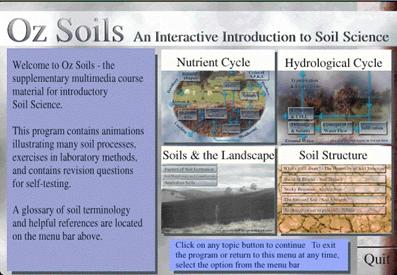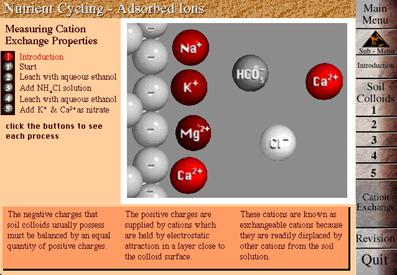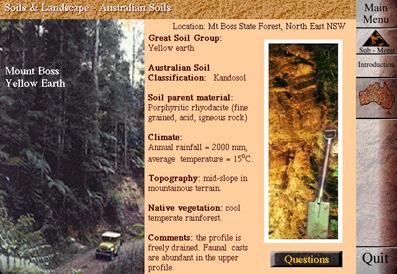What does interactive multimedia offer as a tool for teaching tertiary science?
Peter Lockwood and Heiko DanielDivision of Agronomy and Soil Science
University of New England

What does interactive multimedia offer as a tool for teaching tertiary science?Peter Lockwood and Heiko DanielDivision of Agronomy and Soil Science University of New England |  |
An interactive multimedia program called Oz Soils is being developed at the University of New England. The experiences of the authors in using Oz Soils as part of introductory soil science teaching leads to two questions posed for discussion. Firstly, how can developers and teachers best assess effectiveness and appropriateness in their use of interactive multimedia? Secondly, will interactive multimedia material replace other forms of teaching and how would this affect the learner?
During the development process we have gained experience in the use of educational multimedia in the university environment, and have carried out formative evaluations of Oz Soils (Lockwood & Daniel, 1997; McLeod et al. 1998). Our increasing knowledge of IMM and the results of these evaluations have not only helped us improve the program, but have also led us to reflect more generally on issues concerning the role and effectiveness of IMM in tertiary science education. The purpose of this paper is to pose for discussion two questions, the answers to which we feel are of critical importance to teachers and IMM developers as the use of IMM in education rapidly expands.

Figure 1: The main menu screen from Oz Soils version 2.
These observations would tend to support expanding Oz Soils and making it a larger part of the course, but nonetheless are not convincing evidence that to do so would improve educational outcomes. Indeed a review of the literature showed that educational researchers are not yet able to provide the tools for teachers to rigorously evaluate educational effectiveness of interactive multimedia used as part of a teaching unit (eg Gunn, 1996). These concerns lead to the first question that we would like to pose for discussion. How can developers and teachers best assess effectiveness and appropriateness in their use of interactive multimedia? The cost of developing interactive multimedia programs is high, and the educational consequences of inappropriate use may well be severe.
The opportunity exists to expand the student learning environment by offering additional study material in multimedia form. Mayer and Anderson (1992) and Mayer et al. (1995) showed that in particular novice learners will take great advantage of resource material in multimedia form because the dual coded text and pictorial information helps in creating a conceptual framework for a particular learning issue. Multimedia material may assist students in better appreciating multidisciplinary subjects, such as soil science, where concepts related to chemistry, physics, microbiology, hydrology, engineering, etc., form part of the teaching curriculum.
For example, in preparation for soil science laboratory exercises at the University of New England, students use the Oz Soils multimedia program to help them visualise and gain an improved understanding of submicroscopic processes which cannot directly be observed during the laboratory class. One such example is the measurement of cation exchange capacity. Unprepared students such as those who have difficulty understanding the written practical notes will not be able to fully appreciate these laboratory classes. In such a case the Oz Soils program is designed to facilitate the use of more effective learning strategies.
In the Adsorbed Ions module, which is part of the Nutrient Cycle section (Figure 2), students can interact with animations which aid in constructing a simple mental model of the microscale processes at clay particle surfaces relevant to cation exchange. Students are asked to complete this activity before attending a laboratory class where they measure cation exchange properties. The animation is presented in a number of logical steps which are related to the steps undertaken during the laboratory class. The animation also allows students to go back through the procedural steps or to look again at any particular step in detail. Although students cannot directly observe the microscale processes of cation exchange during the actual laboratory class, the Oz Soil program will have armed the students with a conceptual understanding and a mental picture of each of the analysis steps.

Figure 2: The opening screen of the Oz Soils Adsorbed Ions module.
As another example, before taking part in an excursion, students could expand their understanding of soils and the landscape by using the computer to examine a range of soil sites, their particular soil profile characteristics, and their associated land use. In the Australian Soils module, students explore a number of soil profiles and their associated landscapes from different environments in Australia (Figure 3). Each soil profile/landscape pair includes a set of revision questions which students can use to test their knowledge and understanding, immediately after they have completed the module. Oz Soils records the number of attempts the student makes before selecting the correct answers, and provides feedback in the form of explanations of the answers. This is valuable formative assessment for the student, as it gives an immediate indication of how effective his or her study has been, and if further work is necessary.

Figure 3: A typical scene from the Oz Soils Australian Soils module.
Although the development of effective multimedia teaching material is very costly and time consuming, the end-product may have a low unit cost if widely distributed. Universities are currently being forced to reduce teaching costs and will therefore investigate options to reduce or replace the most costly course components. As a consequence of economic pressures, the use of multimedia programs to offer virtual excursions and simulated laboratory classes could increase at the expense of "hands-on" teaching.
Similar trends may become apparent with the push by universities to deliver an increasing number of courses through the Internet and in the near future with the arrival of interactive television. Both media are more suited to pictorial delivery of information which may change the learner's perception of the study material content. These modes of delivery may potentially be offered to the student without a "hotline" access to the teacher. All of this is assuming that the multimedia material was appropriately developed. There is an added danger that economic pressures could also lead to multimedia products being used which lack research-based design and the implementation of effective learning strategies.
These concerns lead to a second question that we would like to pose for discussion. Will interactive multimedia material replace other forms of teaching and how would this affect the learner?
Gunn, C. (1996). CAL evaluation: What questions are being answered? A response to the article "Integrative evaluation" by Draper et al. Computers in Education, 27, 157-160.
Lockwood, P. V. and Daniel, H. (1997). Computer-assisted teaching in soil science. Sciences of Soils, 2, 1997. http://www.hintze-online.com/sos/1997/Articles/Art5
Mayer, R. E. and Anderson, R. B. (1992): The instructive animation: helping students build connections between words and pictures in multimedia learning. J. Educational Psychology, 84, 444-452.
Mayer, R. E., Steinhoff, K., Bower, G. and Mars, R. (1995). A generative theory of textbook design: Using annotated illustrations to foster meaningful learning of science text. Educational Technology Research and Development, 43, 31-43.
McLeod, R. J., Daniel, H. and Lockwood, P.V. (1998). A Study of learning strategies used by students with the Oz Soils interactive multimedia program. In C. McBeath and R. Atkinson (Eds), Planning for Progress, Partnership and Profit. Proceedings EdTech'98. Perth: Australian Society for Educational Technology. http://www.aset.org.au/confs/edtech98/pubs/articles/mcleod.html
| Authors: Peter Lockwood and Heiko Daniel Division of Agronomy and Soil Science University of New England, NSW 2351 Australia Email: plockwoo@metz.une.edu.au, hdaniel@metz.une.edu.au Please cite as: Lockwood, P. V. and Daniel, H. (1998). What does interactive multimedia offer as a tool for teaching tertiary science? In C. McBeath and R. Atkinson (Eds), Planning for Progress, Partnership and Profit. Proceedings EdTech'98. Perth: Australian Society for Educational Technology. http://www.aset.org.au/confs/edtech98/pubs/articles/lockwood.html |